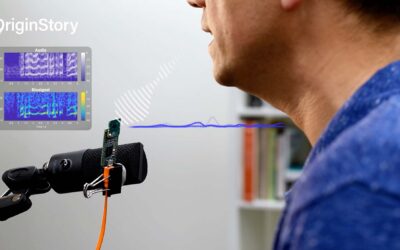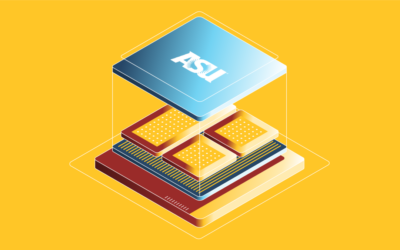From ASU to Artemis: Engineering student helps astronauts suit up for moon mission
By Monique Clement
May 29, 2024
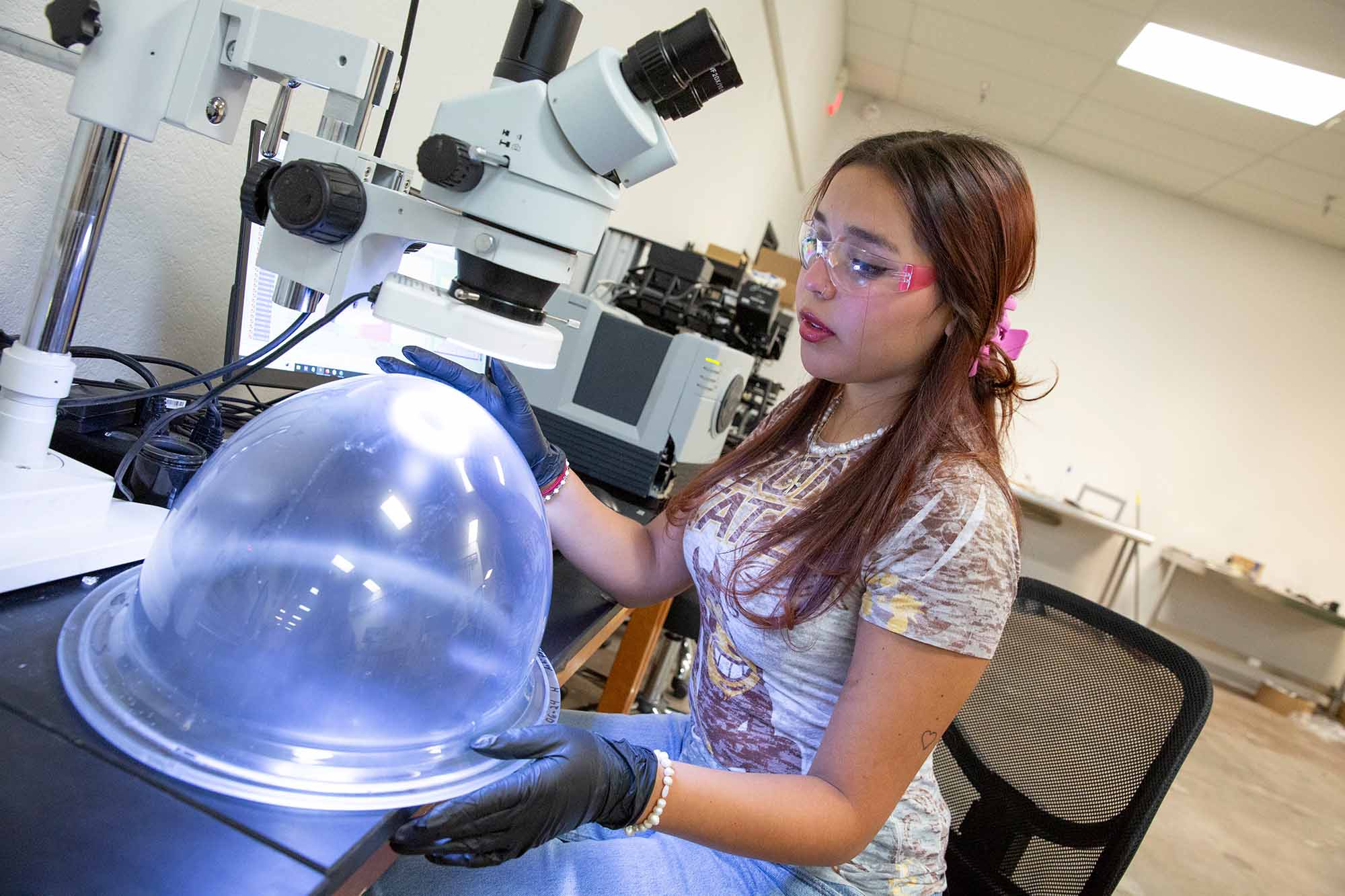
Abril Ramos, a chemical engineering student in the Ira A. Fulton Schools of Engineering at Arizona State University, works on a prototype of a spacesuit helmet with an anti-fog coating developed by Swift Coat, an ASU spinout company. She is part of a team developing a solution for new NASA spacesuits to be used in an upcoming crewed mission to the moon. Photographer: Erika Gronek/ASU
When Abril Ramos first set foot on campus at Arizona State University in the fall of 2021, she had no idea she might be helping NASA astronauts accomplish the first moon mission in the 21st century.
“It’s crazy, especially seeing how it started,” says Ramos, who recently completed her junior year as a chemical engineering major in the Ira A. Fulton Schools of Engineering at ASU.
In the beginning of her engineering journey, Ramos had a simple mission: beat her brother. He had completed a chemical engineering degree at ASU, and Ramos says if her older brother could do it, so could she — and she could do it better.
Ramos’ competitive spirit helped her take a risk in her sophomore year. She applied for an internship at Swift Coat, an ASU spinout company based on research developments by Peter Firth, a Fulton Schools alumnus, and co-founded by Zachary Holman, the Fulton Schools vice dean for research and innovation.
Her decision has turned into a valuable learning experience that has shown the far reaches of where engineering can take her.
Ramos was also instrumental in helping Swift Coat secure a spot as one of two companies funded by NASA to develop a new anti-fog coating for the spacesuits to be worn by the Artemis moon mission crew.
“Swift Coat’s traction with both government grants and commercial customers shows that research at the Fulton Schools enables technology-driven products that have impact in the marketplace,” Holman says. “The fact that both Peter and Abril come from the Fulton Schools shows that ASU’s entrepreneurship ecosystem provides effective training pathways for engineers to succeed both in technology and business.”
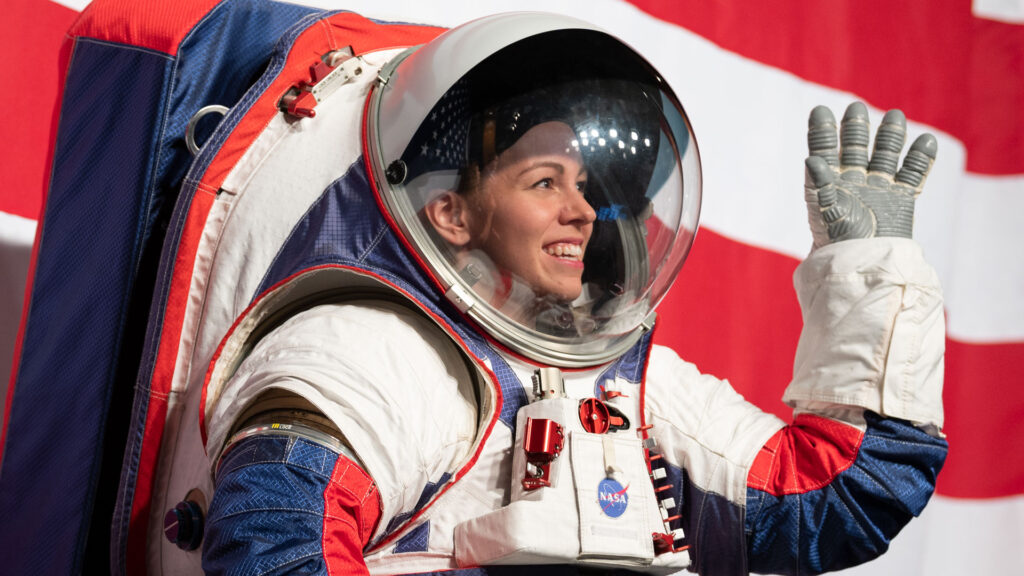
Kristine Davis, a spacesuit engineer at NASA’s Johnson Space Center, wearing a ground prototype of NASA’s new Exploration Extravehicular Mobility Unit, or xEMU, during a 2019 demonstration. Swift Coat’s work is part of a series of Small Business Innovation Research program awards to develop technological solutions for upcoming missions. Photo courtesy of Joel Kowsky/NASA
Clearing the way for next-generation space missions
New anti-fog coatings are a crucial component of future space missions. Cold conditions in space make condensation inside spacesuit helmets a common issue.
In current spacesuits, astronauts apply a solution to the inside of the helmet bubble before exiting a spacecraft. However, the solution must be applied each time and can cause eye irritation — even temporary blindness, as Canadian astronaut Chris Hadfield experienced during the STS-100 mission spacewalk.
NASA was unable to develop an anti-fog coating that could be consistently applied during manufacturing and hold up over prolonged use and cleaning, among other issues. A solution to the problem became one of dozens NASA sought as part of the highly competitive Small Business Innovation Research program, known as SBIR.
“Spacesuits protect us from the hazards of space, but not being able to see outside one could be life-threatening,” says Mark Kelly, a U.S. senator from Arizona and a former astronaut. “During one of my missions, a colleague got anti-fog solution in his eye during a spacewalk, so I know well the need for innovative solutions to these challenges. I’m glad to see that happening right here at ASU, which is playing a growing role in our space program.”
Embarking on an exciting mission
Ramos’ involvement all got started because of math. Those complicated equations engineering students learn are actually used in the real world, and Swift Coat had one of those use cases.
In early 2023, Swift Coat expanded into a 16,000-square-foot facility in north Phoenix.
“We spent the first six months designing and building the laboratory infrastructure,” Firth says. “After spending a half day trying to remember how to size a heat exchanger, I thought, ‘I could have done this in about 10 minutes when I was an undergrad. Maybe we should hire one to help with this kind of stuff.’”
Firth also saw an opportunity to enhance the quality of data collection at Swift Coat.
“Our senior staff have a lot on their plates. Sometimes that means we must triage how much data we collect and how extensively we analyze it,” he says. “We thought if we trained an exceptional undergraduate student on how to use our coating systems and basic materials characterization techniques, they could really enhance what a senior engineer could accomplish in a week.”
So, they hired Ramos. She was surprised to get the internship because it was the first one she applied for, and she was only a sophomore just getting started in her chemical engineering courses.
“It was really nerve-wracking initially because I was their first intern and they didn’t really know what to do with me, and I didn’t really know what to do either,” Ramos says. “It was a learning experience on both sides.”

Swift Coat co-founder Peter Firth demonstrates the company’s self-cleaning coating technology developed during his graduate research at ASU. A diagonal strip in the middle of a glass panel shows water spots where the coating isn’t applied. Combining the company’s thin film coatings in a new way allows for their use in NASA spacesuits to prevent the buildup of condensation that can lead to dangerous conditions during missions. Photographer: Erika Gronek/ASU
An opportunity to make a difference
Firth developed Swift Coat’s core technology — a method for depositing thin films composed of nanoparticles over large areas, called Aerosol Impact Driven Assembly, or AIDA — using the ASU Core Research Facilities while he was a graduate student at ASU. Swift Coat initially used AIDA to produce self-cleaning coatings for windows and solar panels. As part of the company’s work with NASA, Swift Coat expanded the capabilities of AIDA to include highly durable and transparent anti-fog coatings.
Ramos’ role involved managing what are called the “baseline processes” of the technology. She would run the coating process, take measurements and make sure it was within specifications. When it wasn’t — such as coming out too thin or too thick — she let the senior engineers know so they could figure out how to fix it.
“One thing she has done a really good job at over the last year or so is taking it from a point where 50% of the time we ran a process it was in spec, to 90% of the time now,” Firth says.
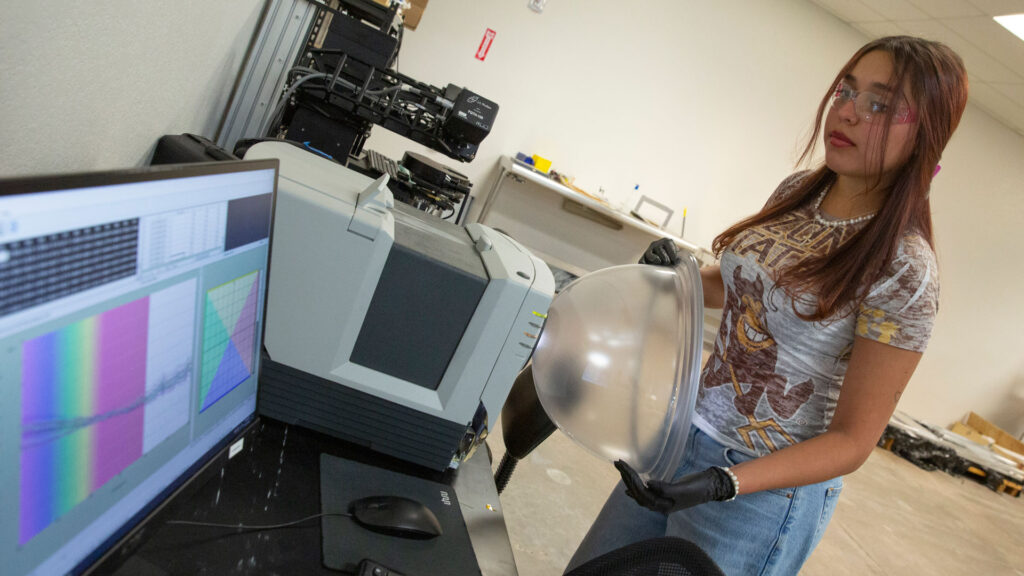
Ramos’ work to measure the output of Swift Coat’s coating process helped the startup’s engineers achieve more consistent results and accelerate development of the technology for uses such as the NASA spacesuit helmet anti-fog coating. Photographer: Erika Gronek/ASU
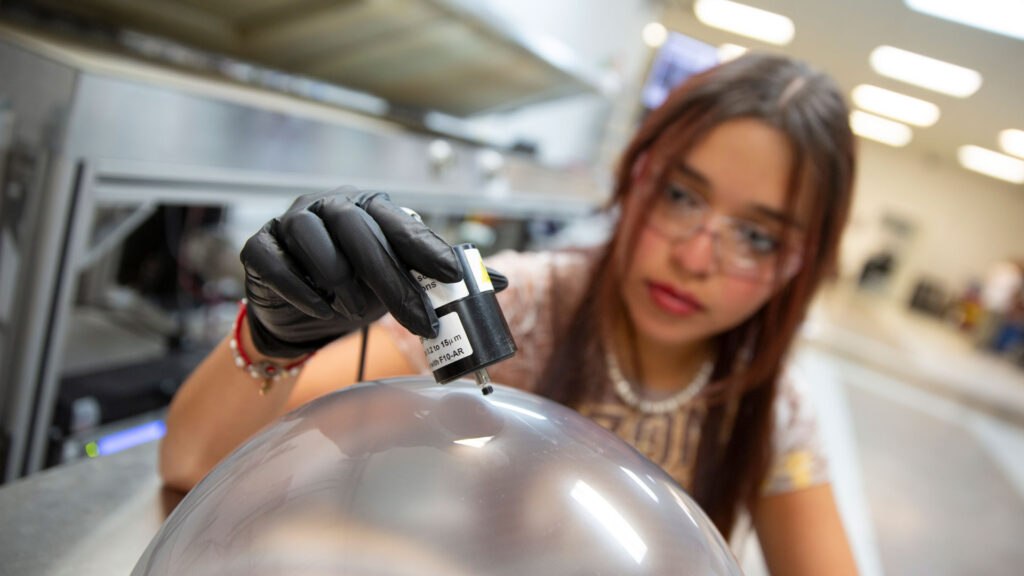
Ramos measures the reflectance, or ability to reflect light and radiation, of the helmet after applying the anti-fog coating. Swift Coat was able to create a full-scale prototype of the coated helmet bubble in the first phase of the NASA-funded project. Photographer: Erika Gronek/ASU
Accelerating development
One of the requirements of the SBIR program was to achieve a consistent coating, something Swift Coat had begun to excel at.
Firth says more than 100 companies applied for the grant in early 2023, and Swift Coat was one of five awarded Phase I funding. That was great news, but the program only allowed six months to make a prototype.
“Typically, coating development in general can last four or five times that long,” Firth says.
NASA was looking for five 1-by-1-inch samples of coated polycarbonate, a type of plastic, upon completion of Phase I of the SBIR program.
“In large part because of Abril’s help, we were able to deliver to NASA a 15-by-15-inch coated substrate, which is the scale they require for the final product,” Firth says.
By working with the helmet manufacturer, they were able to better understand what went into the process and try out their coating on a full-scale polycarbonate helmet surface, Firth says. The prototype isn’t up to NASA’s quality standards — yet — but it is an important step in the right direction.
“Hitting that milestone on a compressed timeline gave NASA a lot of confidence that Swift Coat will take this over the line,” Firth says.
Ramos is glad to have been able to do her part to help the team meet the accelerated deadline.
“It was nice to be able to cut a lot of what would be trial and error down to having confidence in our system,” she says.
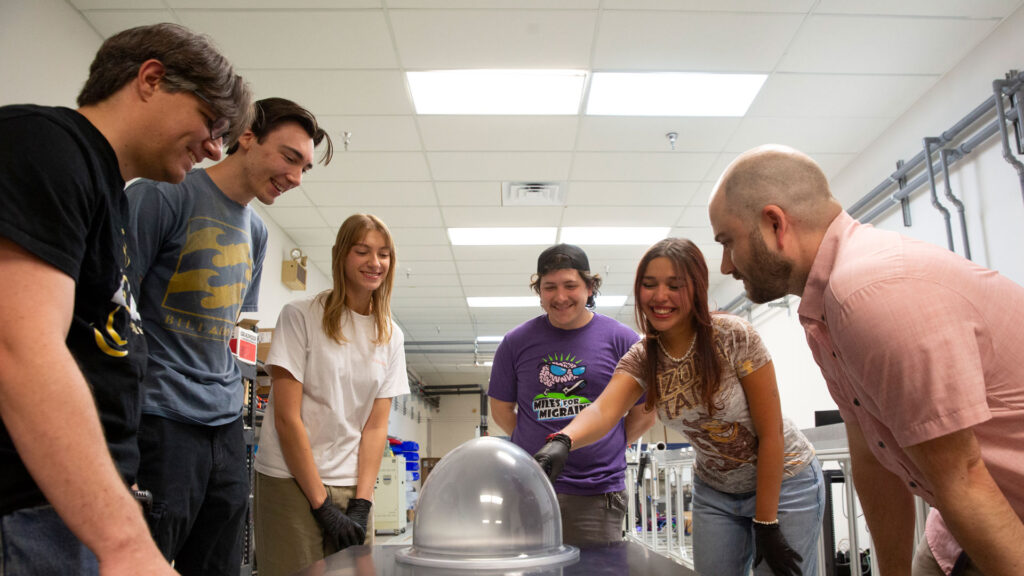
Swift Coat engineering team members (pictured from left to right) Senior Engineer Ty Newhouse-Illige, ASU intern and mechanical engineering major Jacob Sembaluk, ASU intern and chemical engineering major Delaney Bulas, Senior Engineer Ronnie Ramirez, ASU intern Abril Ramos and co-founder Peter Firth examine a prototype of the anti-fog coating on an example spacesuit helmet bubble. Photographer: Erika Gronek/ASU
T-minus two years to new horizons
Swift Coat is now one of only two ventures selected for SBIR Phase II awards, which include $900,000 in funding over two years. For Phase II, their goal is to have the coating prevent fog buildup over a minimum number of “breath cycles” and withstand necessary cleaning.
One of the two companies will likely have their coating used in space missions within the decade. It also has wider applications in the International Space Station and other commercial space exploration uses.
Ramos plans to continue working with Swift Coat over the summer and during her senior year as the company strives to meet the SBIR Phase II challenge. She is joined by two new ASU interns this summer as the internship program has expanded due to her contributions to the team.
She is also embarking on the next phase of her chemical engineering education by starting the Accelerated Master’s degree program in the fall and exploring new ways she can apply her skills.
“Because my brother works on computer chips, I thought that was the only path you can go down as a chemical engineer, but it’s not,” Ramos says. “I didn’t know what thin films were when I started. Now I see they apply to NASA and so many other commercial applications.”
Ramos says she is inspired by Firth’s accomplishments with Swift Coat and seeing other ASU engineering alumni working on an undertaking shared by only one other company.
“It’s really encouraging to see what ASU grads are doing and to know there’s a lot I can do with my education,” Ramos says. “I know there’s a lot of good that can come from this.”
Fulton
Researchers
Peter Firth
Alumnus (2018)
Electrical engineering, PhD
Ira A. Fulton Schools of Engineering
Zachary Holman
Vice Dean for Research and Innovation
Ira A. Fulton Schools of Engineering
Professor
School of Electrical, Computer and Energy Engineering
Related Stories
Engineering low-carbon building materials
A new ASU engineering research center is developing methods to stop the harmful environmental impacts of manufacturing cement
Authenticating audio against AI
OriginStory, a technology developed by ASU researchers to authenticate speech as human, received an award from the U.S. FTC AI Voice Cloning Challenge
Advanced packaging the next big thing in semiconductors — and no, we’re not talking about boxes
ASU plugged into this next breakthrough in microchip tech with curriculum, partnerships with industry leaders
Powering up clean energy systems education
A new Fulton Schools graduate degree launching in fall 2024 will use multiple engineering disciplines to help reach the goal of a more sustainable future.

